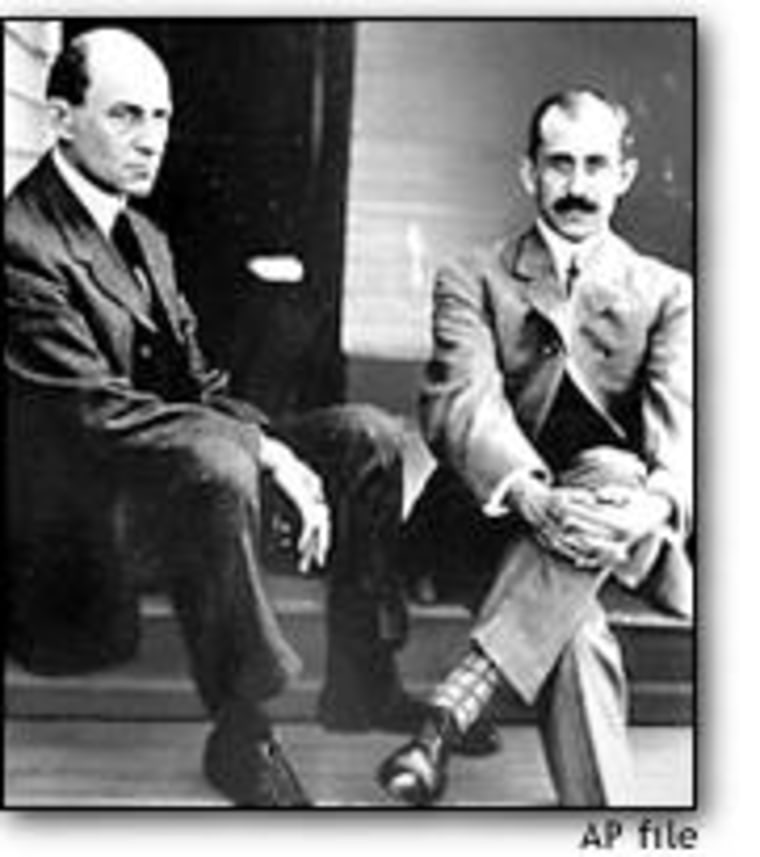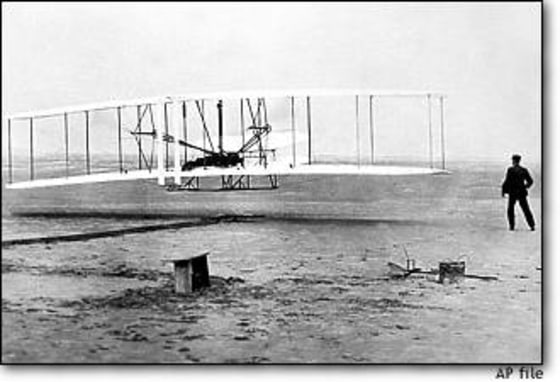Beneath the Wright brothers’ frail aircraft that altered history, a yearlong series of centennial events began in the Smithsonian on Tuesday, the 99th anniversary of the first powered flight.
In North Carolina, 99 military aircraft roared in tribute over the dunes where the Wright Flyer sputtered aloft.
The day’s third activity to inaugurate the centennial year was in Dayton, Ohio, where Orville and Wilbur Wright owned a bicycle shop. A $1 million visitors center was dedicated there, overlooking the field where the brothers developed and tested their plane.
“The last 100 years have been absolutely amazing, but that’s only a precursor to what can be,” former astronaut John Glenn, the first American to orbit the earth, told a group that included relatives of Charles Lindbergh, the Wrights and Amelia Earhart. “I have no doubt within the next 100 years we really will have gone to Mars.”
Glenn and Neil Armstrong, who took the “giant leap for mankind” as the first human on the moon, were among an eclectic group of 12 aviation pioneers honored in Tuesday’s ceremony at the Smithsonian’s National Air and Space Museum.

Sitting almost directly beneath the Wright Flyer, suspended from the museum ceiling, Amanda Wright Lane, great-grandniece of the Wright brothers, said her strait-laced great-uncles would have been quietly pleased with the recognition.
“But they would have avoided the spotlight,” Lane said. “Large crowds and ceremonies were not their cup of tea.”
Other aviation pioneers honored were Lindbergh, whose trans-Atlantic single-engine “Spirit of St. Louis” also hangs in the museum, represented by his grandson, Erik; Amelia Earhart, represented by niece Amy Kleppner; Gen. David Lee “Tex” Hill, World War II ace; Col. Charles McGee, representing the Tuskegee Airmen; Shannon Lucid, NASA’s chief scientist; Pamela Melroy, NASA astronaut; Jody McCarrell, president of the Ninety Nines flying group; Henry Ford, founder of Ford Motor Co., represented by his great-grandson Edsel Ford II; and Vance Coffman, chairman and chief executive officer of Lockheed Martin Corp.
North Carolina monument
At Kill Devil Hills, near Kitty Hawk on North Carolina’s Outer Banks, descendants of six of the eight witnesses to the first flight, at 10:35 a.m. on Dec. 17, 1903, placed a half-dozen wreaths at the foot of a 1928 monument in the Wright Brothers National Memorial marking the spot where the Flyer took off.
An audience of about 2,000 watched as the 99 aircraft flew over in the same weather conditions that drew the Wright brothers to the North Carolina coast — strong, sustained wind and a clear sky. A solo parachutist spiraled to earth trailing red smoke, followed by members of the Army’s Golden Knights parachute team who glided to earth about 50 feet from the granite marker where the first flight ended.
Century of aviation feats
It seemed unlikely that two bicycle makers from Dayton could change the world as they did on that winter day 99 years ago. Orville, who won the honor in a coin toss to become the first powered pilot, piloted the Wright Flyer 120 feet along the dunes, staying aloft for 12 seconds. It was the first of four short flights that day; the longest was 852 feet.
The historic flight ushered in a century of aviation feats, from development of the jet engine to international travel to landings on the moon. The last man there, Eugene Cernan, left a plaque that said: “Here Man completed his first exploration of the Moon December 1972 A.D. May the spirit of peace in which we came be reflected in the lives of all mankind.”
Glenn predicted the next milestone in flight will be a breakthrough in propulsion technology that can push spacecraft faster and farther into space, making possible a manned mission to Mars.
“I doubt if I’ll live quite that long,” joked Glenn. His last venture into space was aboard the space shuttle just four years ago, at age 77.
